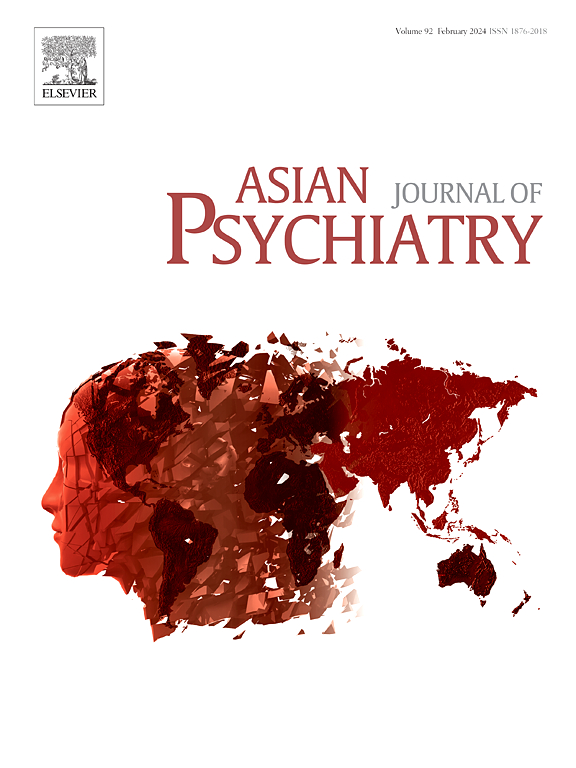Neuroimaging biomarkers distinguishing medication-naïve adolescents with major depressive disorder and bipolar disorder during depressive episodes
IF 4.5
4区 医学
Q1 PSYCHIATRY
引用次数: 0
Abstract
Background
The adolescent period represents a critical window of heightened vulnerability for the onset of major depressive disorder (MDD) and bipolar disorder (BD). Nevertheless, the neuro-metabolic abnormalities in adolescents with MDD and BD remain incompletely understood, and the early differentiation between MDD and BD in depressive episodes continues to pose significant clinical challenges.
Method
This study involved the recruitment of 60 adolescent MDD, 50 adolescent BD patients in depressed episodes, and 48 demographically matched healthy controls (HCs). Proton magnetic resonance spectroscopy (1H-MRS) was used to measure N-acetylaspartate (NAA), choline-containing compounds (Cho), and creatine (Cr) in the prefrontal white matter (PWM), putamen, and thalamus.
Results
The results showed that both MDD and BD in depressive episodes exhibited extensive neurometabolic differences compared to HCs, and post hoc comparisons between MDD and BD revealed that adolescent patients with BD had higher left Putamen NAA/Cr ratios (P = 0.002) and lower left Thalamus NAA/Cr ratios (P = 0.018) compared to MDD. By developing a multivariate logistic regression model based on the NAA/Cr ratios of these two brain regions, an ROC curve was constructed (AUC=0.735), which can to some extent distinguish BD in depressive episodes from MDD.
Conclusion
Adolescent MDD patients and BD patients exhibit both similarities and differences in neurometabolism. The neurometabolic differences in left Putamen NAA/Cr ratios and left Thalamus NAA/Cr ratios between adolescent MDD patients and BD patients in depressive episodes may help in identifying adolescent BD patients early through 1H-MRS.
神经成像生物标志物区分medication-naïve青少年抑郁症和双相情感障碍在抑郁发作期间
背景:青少年时期是重性抑郁障碍(MDD)和双相情感障碍(BD)发病易感性增加的关键时期。然而,青少年MDD和BD的神经代谢异常仍然不完全清楚,抑郁症发作中MDD和BD的早期区分仍然构成重大的临床挑战。方法本研究招募60名青春期重度抑郁症患者、50名抑郁发作的青春期双相障碍患者和48名人口统计学匹配的健康对照(hc)。采用质子磁共振波谱法(1H-MRS)测定前额叶白质(PWM)、壳核和丘脑中n -乙酰天冬氨酸(NAA)、含胆碱化合物(Cho)和肌酸(Cr)的含量。结果结果显示,抑郁发作的MDD和BD与hcc相比都表现出广泛的神经代谢差异,MDD和BD之间的事后比较显示,与MDD相比,青春期BD患者左侧壳核NAA/Cr比值较高(P = 0.002),左侧丘脑NAA/Cr比值较低(P = 0.018)。基于这两个脑区NAA/Cr比值建立多元logistic回归模型,构建ROC曲线(AUC=0.735),可以在一定程度上区分抑郁发作的BD与MDD。结论青少年MDD患者与BD患者在神经代谢方面既有相似之处,也有差异。青少年MDD患者和BD患者抑郁发作时左壳核NAA/Cr比值和左丘脑NAA/Cr比值的神经代谢差异可能有助于通过1H-MRS早期识别青少年BD患者。
本文章由计算机程序翻译,如有差异,请以英文原文为准。
求助全文
约1分钟内获得全文
求助全文
来源期刊

Asian journal of psychiatry
Medicine-Psychiatry and Mental Health
CiteScore
12.70
自引率
5.30%
发文量
297
审稿时长
35 days
期刊介绍:
The Asian Journal of Psychiatry serves as a comprehensive resource for psychiatrists, mental health clinicians, neurologists, physicians, mental health students, and policymakers. Its goal is to facilitate the exchange of research findings and clinical practices between Asia and the global community. The journal focuses on psychiatric research relevant to Asia, covering preclinical, clinical, service system, and policy development topics. It also highlights the socio-cultural diversity of the region in relation to mental health.
 求助内容:
求助内容: 应助结果提醒方式:
应助结果提醒方式:


